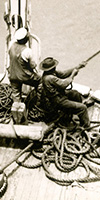Collections
-

-
Herman T. Pott National Inland Waterways Library
-
The Herman T. Pott National Inland Waterways Library is a special library within the St. Louis Mercantile Library, at the University of Missouri-St. Louis. Among its holdings are circulating and reference collections of materials related to rivers, shipping, navigation, and leisure on inland waterways, particularly within the United States. The Pott Library also hosts extensive art and archival collections. Parts of these collections may be available through the digital library, but the full collections may be better accessed in person. For a complete list with finding aids, see the Pott Library Collections Directory for more information.
-

-
John W. Barriger National Railroad Library
-
The John W. Barriger III National Railroad Library is a special library within the St. Louis Mercantile Library, at the University of Missouri-St. Louis. It holds some of North America's largest and finest railroad history collections. Named after the noted twentieth century railroad executive, John W. Barriger, III (1899-1976), whose collection forms its heart, the library has grown to become a major resource for the history of railroad business and technology as well as for the study of railroading’s multidimensional influence on the American economy, society and culture. The Barriger Library also hosts extensive art and archival collections. Parts of these collections may be available through the digital library, but the full collections may be better accessed in person. For a complete list with finding aids, see the Barriger Library Collections Directory for more information.
Support for the Barriger Library's digitization efforts is provided by generous grants from our members, the Barriger Library Board and The Union Pacific Foundation, the CSX Foundation, the NS Foundation and the KCS Foundation.
-

-
M-322: Dr. Allen B. and Helen S. Shopmaker American Political Collection
-
The Shopmaker Collection contains over three thousand items ranging from a George Washington token dated 1789 to buttons and textiles endorsing candidates in the 2008 election. The variety of objects reflects the changing tastes of the American public and the available production technologies, ranging from 19th century brass jewelry and clothing buttons embossed with candidate's names and party symbols to today's modern, mass-produced buttons, and from porcelain plates embellished with a portrait of First Lady Helen Taft to Nancy Reagan paper dolls. With artifacts representing nearly every American election, the Shopmaker Collection provides the viewer with a broad look at how candidates have used images, slogans and symbols to woo the public, and how the public has expressed its own, often outspoken, opinions on both individuals and issues.
-

-
St. Louis Mercantile Library
-
The St. Louis Mercantile Library at the University of Missouri-St. Louis is the oldest library in the St. Louis region. It holds many records and artifacts of importance to the history of St. Louis and the American West. The special collections of the Mercantile Library consist of more than 400 individual collections with archival materials numbering in the millions, including over 100 historic newspaper titles, presidential letters, early travel diaries and civil war era letters, fur trade records and the newspaper and printing morgue of the St. Louis Globe Democrat. Parts of these collections may be available through the digital library, but the full collections may be better accessed in person. For a complete list with finding aids, see the St. Louis Mercantile Library Special Collections Directory for more information.
-

-
St. Louis Mercantile Library Art Museum
-
The St. Louis Mercantile Library has, since its founding, considered art as essential to accomplishing its educational and cultural mission. Inspired by its first exhibited work of art – a painting lent by Charles Deas – the Library has developed a significant permanent collection of paintings, prints, drawings, sculpture, decorative arts and folk art. These works relate to and complement the Library’s archival and manuscript holdings by providing visual documentation of the physical and cultural development of our city, state, and nation.
